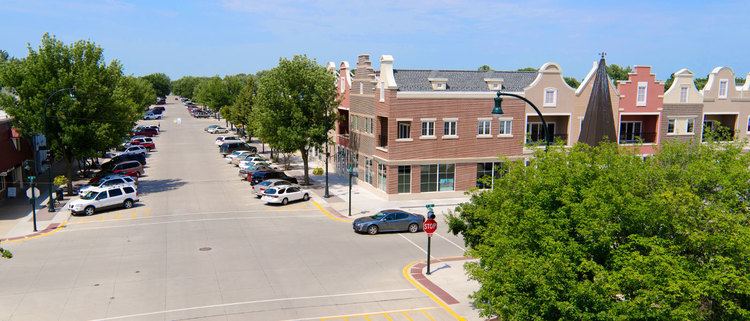Country United States Elevation 1,444 ft (440 m) Zip code 51041 Local time Saturday 10:25 PM | State Iowa Incorporated February 29, 1884 Time zone Central (CST) (UTC-6) Population 6,182 (2013) | |
 | ||
Weather 3°C, Wind E at 14 km/h, 100% Humidity | ||
Orange City is a city in and the county seat of Sioux County, Iowa, United States. The population was 6,004 in the 2010 census, an increase from 5,582 in the 2000 census. Named after William of Orange, it is best known for its Dutch background, which it celebrates with an annual Tulip Festival for 3 days every May. Many of the city's buildings are faced with Dutch architectural fronts.
Contents
- Map of Orange City IA 51041 USA
- History and culture
- Geography
- 2010 census
- 2000 census
- Economy
- Education
- Religion
- Notable people
- References
Map of Orange City, IA 51041, USA
History and culture
Orange City was first called Holland and was later renamed in honor of Dutch royalty. The city was founded in 1870 by settlers from Pella, Iowa looking for cheaper and better land.
As the county seat of Sioux County, the city is the location of the Sioux County Courthouse, which is listed on the National Register of Historic Places.
Geography
Orange City is located at 43°0′20″N 96°3′32″W (43.005498, -96.058796).
According to the United States Census Bureau, the city has a total area of 3.94 square miles (10.20 km2), all of it land.
2010 census
As of the census of 2010, there were 6,004 people, 1,905 households, and 1,405 families residing in the city. The population density was 1,523.9 inhabitants per square mile (588.4/km2). There were 2,004 housing units at an average density of 508.6 per square mile (196.4/km2). The racial makeup of the city was 93.2% White, 0.6% African American, 0.3% Native American, 1.4% Asian, 3.4% from other races, and 1.0% from two or more races. Hispanic or Latino of any race were 7.0% of the population.
There were 1,905 households of which 33.8% had children under the age of 18 living with them, 67.0% were married couples living together, 4.7% had a female householder with no husband present, 2.0% had a male householder with no wife present, and 26.2% were non-families. 23.5% of all households were made up of individuals and 10.5% had someone living alone who was 65 years of age or older. The average household size was 2.61 and the average family size was 3.08.
The median age in the city was 29.1 years. 23.1% of residents were under the age of 18; 22.2% were between the ages of 18 and 24; 19.3% were from 25 to 44; 20.7% were from 45 to 64; and 14.7% were 65 years of age or older. The gender makeup of the city was 47.3% male and 52.7% female.
2000 census
As of the census of 2000, there were 5,582 people, 1,719 households, and 1,285 families residing in the city. The population density was 1,808.5 people per square mile (697.5/km²). There were 1,805 housing units at an average density of 584.8 per square mile (225.5/km²). The racial makeup of the city was 97.51% White, 0.50% African American, 0.05% Native American, 0.97% Asian, 0.61% from other races, and 0.36% from two or more races. Hispanic or Latino of any race were 1.13% of the population.
There were 1,719 households out of which 35.8% had children under the age of 18 living with them, 69.8% were married couples living together, 4.0% had a female householder with no husband present, and 25.2% were non-families. 23.9% of all households were made up of individuals and 10.8% had someone living alone who was 65 years of age or older. The average household size was 2.58 and the average family size was 3.07.
Age spread: 22.7% under the age of 18, 24.9% from 18 to 24, 20.2% from 25 to 44, 16.3% from 45 to 64, and 15.9% who were 65 years of age or older. The median age was 28 years. For every 100 females there were 85.7 males. For every 100 females age 18 and over, there were 80.6 males.
The median income for a household in the city was $39,721, and the median income for a family was $49,076. Males had a median income of $33,965 versus $21,130 for females. The per capita income for the city was $17,413. About 4.4% of families and 4.8% of the population were below the poverty line, including 3.8% of those under age 18 and 10.7% of those age 65 or over.
Economy
Major companies headquartered in Orange City include Diamond Vogel Paints, Pizza Ranch, Revival Animal Health Systems, and Quatro Composites.
Employers in Orange City are:
Education
Several schools are found in Orange City. Two elementary schools, Orange City Elementary, which is part of the MOC-Floyd Valley Community School District, and Orange City Christian School, serve the community. There are also two high schools: MOC-Floyd Valley High School and Unity Christian High School.
Orange City is home to Northwestern College, a Christian liberal arts college affiliated with the Reformed Church in America. As of August 2011, 1,243 students were enrolled - 59% female and 41% male.
It is also within thirty miles of Northwest Iowa Community College in Sheldon, Iowa, which was started in 1966 as a pilot program sponsored by the Department of Education in cooperation with the local high schools. It enrolls over 1,000 students per year (58% female, 42% male as of 2005).
Religion
Orange City is traditionally a Dutch Reformed community with several congregations from the Christian Reformed Church of North America, United Reformed Churches in North America, and Reformed Church in America denominations. There are also congregations from the Lutheran Church–Missouri Synod, Southern Baptist Convention, Presbyterian Church in America, Episcopal, Christian and Missionary Alliance, and Evangelical Free Church of America denominations. A Catholic church is located in Alton, IA, 3 miles East of Orange City.
